1912
Dresses influenced by the Edwardian era, about 1901 to 1910, were often light in color and materials, High collars and long skirts covered a woman from chin to floor. Charles Dana Gibson’s Gibson Girl represented the fashion ideal.
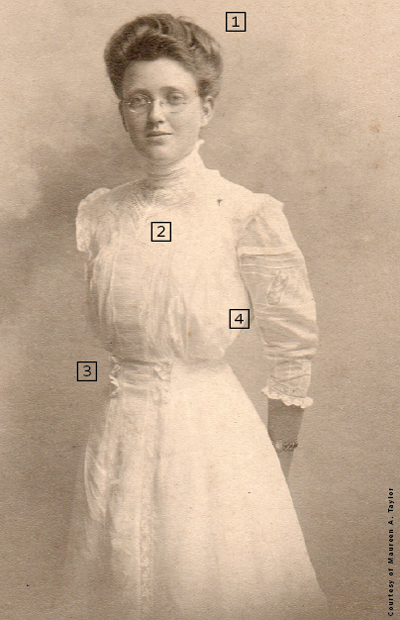
2. High, lacy necklines are typical of the era.
3. Full corsets cinched women’s waists.
4. The pouchy bodice over an a-line skirt was a common silhouette.
1914
The Progressive Era, about 1890 to 1920, saw women playing more active roles in causes such as workers’ rights, child labor laws and voting rights. In 1890, two suffrage organizations joined to form the National American Woman Suffrage Association (NAWSA); membership started at just 7,000 and eventually reached 2 million. Against this background, the buttoned-up Edwardian look gave way to a more relaxed, layered-looking silhouette. Corsets became less rigid and restrictive, collars lowered and clothing fit more loosely.
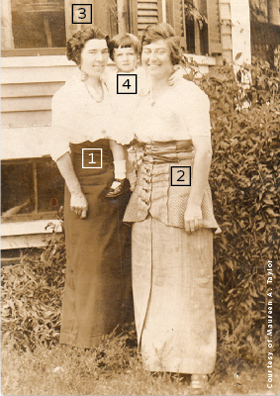
2. This woman’s outfit features a short overskirt.
3. Women were beginning to wear their hair pinned up and tight to the head.
4. Bobbed hair became popular for children; young women would adapt the style in the 1920s.
circa 1915
Although the “war crinoline” (a full, calf-length skirt) enjoyed brief popularity as the Great War began in Europe, overall trends continued toward practical, looser clothing and fabric-conserving shorter, a-line skirts. Hats gradually shrunk over the decade. Tunic-length tops and jackets also were a popular silhouette, and French designer Gabrielle “Coco” Chanel popularized casual knitwear.
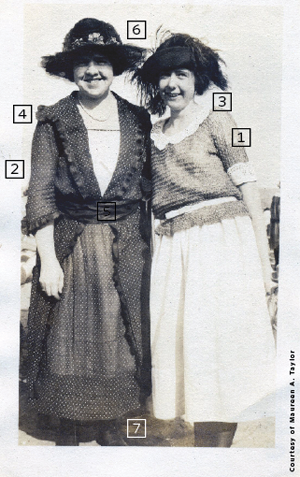
2. A wide-collared wrapper acts as an overskirt to this separate skirt and shirt outfit.
3. Many dresses are loose fitting with sloping shoulders.
4. Pre-WWI high necklines gave way to wide-open collars on dresses and blouses.
5. Belts accent the ladies’ natural waists.
6. Daisies and feathers decorate their hats.
7. Calf-length skirts might be worn with shoes or boots.
1917
World War I propelled women into the workforce in unprecedented numbers. The Woman’s Land Army of America employed 20,000 in agriculture. In 1918, when the US Department of Labor created the Women in Industry Service, the food, textile and war industries had 3 million new female employees. In Britain, 1.6 million women joined the workforce from 1914 to 1918. Both countries recruited women to military jobs. More than 21,000 women served as US Army nurses at home and abroad. This woman was one of the US Navy’s 11,000 female yeomen, designated “yeoman (F),” who filled clerical positions from 1917 to 1921. The work required practical attire, such as shorter skirts and even trousers.
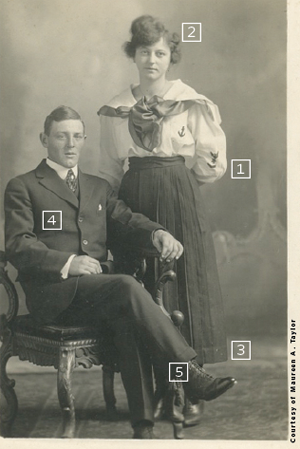
2. Young women’s wartime hairstyles were tight to the head with fullness at the top of the head or over the forehead.
3. A calf-length skirt was more practical for working.
4. The man’s jacket is narrow-fitting and worn with a silk necktie.
5. Spats, originally worn to protect the lower legs against mud and water, became a fashionable men’s accessory from 1910 to the 1930s.
1917
In an effort to build the perception of suffragists as patriotic and hard workers, NAWSA and its leader Carrie Chapman Catt consciously linked the concept to women’s war service. The Women’s Liberty Loan committee coordinated campaigns to sell US treasury bonds, which helped fund war effort. The variety of clothing in this 1917 photograph of the committee in Washington, D.C., shows the ongoing fashion transition. Older women tended to adopt the newer, boxier styles more slowly than their younger daughters and granddaughters.
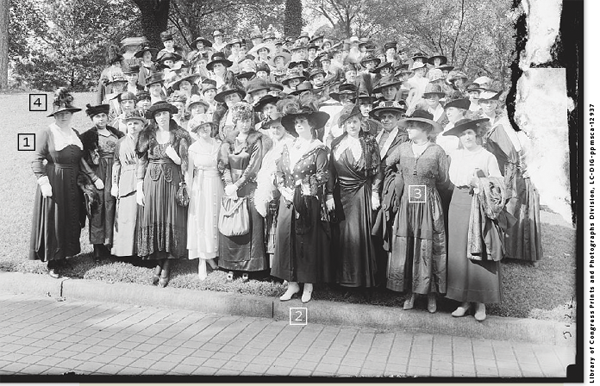
2. Ankle-length skirts were a compromise between the formerly popular floor-length styles and the more-fashionable calf length that many younger women wore.
3. Pleats or gored panels create full skirts.
4. Though still de rigueur, headwear was less elaborate than in the past: small toques, turned-up brims, or flat brims with trim.
circa 1922
The 19th amendment to the Constitution was ratified Aug. 18, 1920, and women achieved the vote. Along with this freedom went a freer style of dress. Dresses took on a straight silhouette with a dropped waist. Skirt hemlines continued to rise to reach just below the knee in 1927; shoes had higher heels to complement shorter skirts. Women often bound their chests rather than wear corsets. They pinned up long hair to look short, then eventually cropped it. The new styles ushered in the “flapper” look of the mid- to late 1920s, symbolizing a carefree attitude that rebelled against the previous generation’s standards of behavior for young women.
1. Shapeless bodices featured wide necklines and dropped waists.
2. Calf-length skirts continued to shorten into the 1920s.
3. Young women cut their hair short in the latest styles with names like the “wavy shingle.”
4. Shoes showed ankle and a bit of the foot.
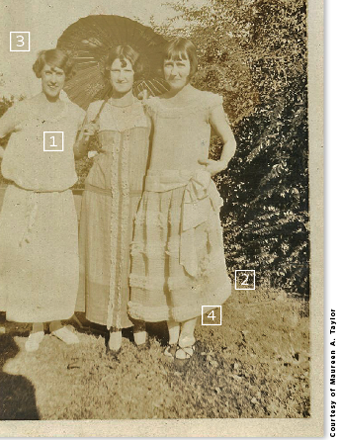
WWI Fashion Resources
- 11 Fashion Trends of World War I
- Dressed for the War, Uniforms, Civilian Clothing and Trappings, 1914-1918 by Nina Edwards (I.B.Tauris)
- Fashion: Women in World War One by Lucy Adlington (History Press)
- Fighting on the Home Front: The Legacy of Women in World War One by Kate Adie (Hodder)
- Great War Fashion: Tales from the History Wardrobe by Lucy Adlington (The History Press)
- Women’s Fashion During WWI: 1914-1920
WWI Fashion Timeline
- French designer Paul Poiret brings his fashion show to New York, inspiring a wartime trend of fundraising fashion shows.
- The assassination of Archduke Ferdinand, heir to the throne of Austro-Hungary, sets off a chain of events that leads to war.
- Burberry patents an all-weather breathable fabric, used to make trench coats for the British Army. Coco Chanel adapts it for everyday wear.
- Mary Phelps Jacob applies for a patent for her brassiere design.
- War in Europe shuts down Paris couture houses, giving New York City a chance to become a fashion capital.
1915
- A German submarine sinks the RMS Lusitania, killing 1,198 people, including 128 Americans.
- American inventor Maurice Levy designs a metal case for lipstick, spurring the mass production of the cosmetic.
- Maybelline begins offering affordable make-up; Helena Rubenstein and Elizabeth Arden open beauty salons in New York.
- Ballroom dancer Irene Castle cuts her hair into the “Castle bob” as a matter of convenience.
1916
- Harpers Bazaar features Coco Chanel’s drop-waist dress.
- Montana elects the first US Congresswoman, Jeannette Rankin.
1917
- President Woodrow Wilson asks Congress to go to war with Germany, declaring “The world must be made safe for democracy.”
- The number of women employed by the Pennsylvania Railroad more than doubles to 3,700 in less than five months.
- The US Navy authorizes the enlistment of women as yeomen (F), unofficially known as Yeomanettes.
- Women answer the government’s request to forgo corset purchases, and save enough metal to build two battleships.
1918
- The wristwatch replaces the pocket watch as a timepiece for men.
- A soldier at Fort Riley, Kan., is diagnosed with a new strain of flu. The Spanish flu pandemic kills 50 to 100 million people worldwide before it ends in 1920.
1920
- The 19th amendment gives women the right to vote.
- Olive Thomas stars in Frances Marion’s silent film The Flapper.
More Online
Photo Detective blog
Timeline of WWI war declarations
The best way to label old photos
Women in World War I research guide
Historical hairstyles
Fashion clues by the decade
Family Photo Detective
How to Archive Family Photos
WWI Genealogy Websites downloadable guide




